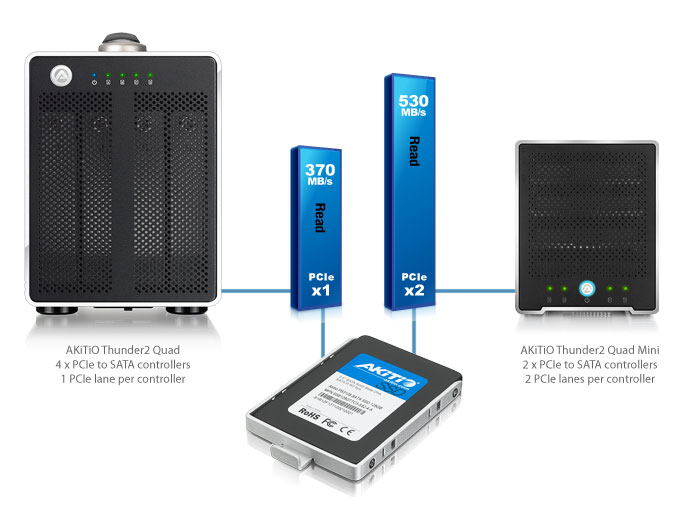What Are Sata 6gb/s Ports Used For
Solid state drives (SSDs) provide faster data transfer rates than mechanical hard deejay drives (HDD's) but how fast can an SSD with a SATA interface really go and what is needed to achieve the best possible speeds in an external storage enclosure?
A single SSD with a SATA 6Gb/south interface, also known as SATA-Iii or SATA iii, can deliver speeds of about 500-550MB/due south. This means that the storage enclosure should accept a USB 3.1 Gen 2 interface at 10Gbps or a Thunderbolt interface to provide sufficient bandwidth. Withal, when it comes to Thunderbolt enclosures, not all are built the aforementioned way and if you lot plan on getting the most out of a single SSD, you demand to make sure that the SATA controller also provides enough bandwidth to run at total SATA 6Gb/s speeds.
PCIe to SATA controller
The SATA controller in the Thunderbolt enclosure connects to the computer through PCI Express (PCIe). One Gen-2 PCIe lane has a bandwidth of 5Gb/s, so if the SATA controller makes use of merely one PCIe lane, the performance of the SSD is express to about 370MB/s. These are all the same good speeds simply not the maximum the SSD can reach. If, on the other mitt, the SATA controller makes utilise of two Gen-2 PCIe lanes, the SSD can run at total 6Gb/s speeds and evangelize transfer rates of over 500MB/s.
Here are some of the AKiTiO Thunderbolt products that make use of two Gen-2 PCIe lanes per controller and can therefore deliver summit speeds for unmarried SSDs:
- AKiTiO Thunder2 Duo Pro
- AKiTiO Thunder2 Quad Mini
- AKiTiO Thunder3 Duo Pro
- AKiTiO Thunder3 Quad Mini
- AKiTiO ThunderGo
- AKiTiO Thunder SATA Go
1 PCIe lane vs ii PCIe lanes
What does that hateful for other Thunderbolt products that only use one PCIe lane? The answer to that is that information technology depends on the amount of drives and if a RAID fix is created with those drives or not. For instance, the AKiTiO Thunder2 Quad and the AKiTiO Thunder3 Quad were created mainly for 3.five" drives and use only one PCIe lane per drive. If you install a single SSD, it will therefore max out at around 370MB/s.
When you install 4 SSDs and create a RAID 0 set, the bottleneck will be around 1375MB/due south for four Gen-2 PCIe lanes. For the Thunder2 Quad, this is as well the clogging of the Thunderbolt 2 interface. For the Thunder3 Quad, even though the Thunderbolt 3 interface is capable of faster speeds than that, due to the SATA Controller, the bottleneck is still only 1375 MB/south.
For a storage enclosure designed but for ane drive like the AKiTiO ThunderGo, having ane or 2 PCIe lanes makes a big difference. In that case, it tin mean an increase in transfer rates of effectually 160MB/s, which can definitely be felt when transferring and accessing the data on that drive.

AKiTiO Thunder2 Quad Mini & AKiTiO Thunder3 Quad Mini
Concluding merely not least, a tip for users of our AKiTiO Thunder2 Quad Mini and the AKiTiO Thunder3 Quad Mini, which are based on two PCIe to SATA controllers. To get the most out of but two SSD's, install ane bulldoze in slot A (or B) and 1 drive in slot C (or D). That way, each drive gets two PCIe lanes and tin can run at full SATA 6Gb/s speeds. In the real world, this ways that you can get over 500MB/s for a single drive or over 1000MB/south for two drives in a RAID 0 fix.
When yous stripe four SSDs, the maximum transfer rate with four Gen-2 PCIe lanes and the Thunderbolt 2 interface of the Thunder2 Quad MIni is about 1375 MB/s. For the Thunder3 Quad Mini, fifty-fifty though the Thunderbolt 3 interface is capable of speeds faster than that, due to the SATA controllers, the bottleneck is nonetheless only well-nigh 1480 MB/due south.

What Are Sata 6gb/s Ports Used For,
Source: https://www.akitio.com/blog/articles/full-sata-6gbs-speeds
Posted by: flowersarkly1973.blogspot.com


0 Response to "What Are Sata 6gb/s Ports Used For"
Post a Comment